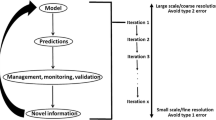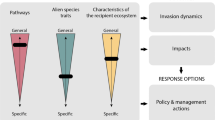Abstract
Understanding why some introduced species become naturalized and invasive whereas others do not is a major focus of invasion ecology. Invasive species risk assessments address this same question, but are not typically based on the results from recent ecological studies. Applying results from the ecological literature to risk assessment is difficult, in part because there are no general explanations of invasion likelihood across taxa. Most ecological studies are also specific to a particular region and it is unclear whether outcomes in one region will necessarily apply to another. Here we show how a hierarchical Bayesian statistical framework can make better use of ecological studies for applied risk assessments. We focus on three key opportunities afforded by these models: (1) the ability to leverage information from one region to form prior expectations for other regions about which little is known, (2) the ability to quantify uncertainty of predictions, and (3) flexibility to incorporate within-group heterogeneities in probabilities of naturalization. We illustrate these principles using a case study where we predict the probability of plant taxa naturalizing in New Zealand and Australia, showing how prior information can be particularly valuable when data are limited. As more studies document invasion patterns around the world, a framework that can formally incorporate prior information will help link the accumulating data on species introductions to risk assessments.





Similar content being viewed by others
References
Affre L, Suehs CM, Charpentier S, Vila M, Brundu G, Lambdon P, Traveset A, Hulme PE (2010) Consistency in the habitat degree of invasion for three invasive plant species across Mediterranean Islands. Biol Invasions 12:2537–2548
Blackburn TM, Duncan RP (2001) Determinants of establishment success in introduced birds. Nature 414:195–197
Caley P, Lonsdale WM, Pheloung PC (2006) Quantifying uncertainty in predictions of invasiveness. Biol Invasions 8:277–286
Chytry M, Pysek P, Wild J, Pino J, Maskell LC, Vila M (2009) European map of alien plant invasions based on the quantitative assessment across habitats. Divers Distrib 15:98–107
Clark JS (2007) Models for ecological data: an introduction. Princeton University Press, Princeton
Daehler CC (1998) The taxonomic distribution of invasive angiosperm plants: ecological insights and comparison to agricultural weeds. Biol Conserv 84:167–180
Dawson W, Burslem D, Hulme PE (2009a) Factors explaining alien plant invasion success in a tropical ecosystem differ at each stage of invasion. J Ecol 97:657–665
Dawson W, Burslem D, Hulme PE (2009b) The suitability of weed risk assessment as a conservation tool to identify invasive plant threats in East African rainforests. Biol Conserv 142:1018–1024
Diez JM, Buckley HL, Case BS, Harsch MA, Sciligo AR, Wangen SR, Duncan RP (2009a) Interacting effects of management and environmental variability at multiple scales on invasive species distributions. J Appl Ecol 46:1210–1218
Diez JM, Williams PA, Randall RP, Sullivan JJ, Hulme PE, Duncan RP (2009b) Learning from failures: testing broad taxonomic hypotheses about plant naturalization. Ecol Lett 12:1174–1183
Duncan RP, Bomford M, Forsyth DM, Conibear L (2001) High predictability in introduction outcomes and the geographical range size of introduced Australian birds: a role for climate. J Anim Ecol 70:621–632
Ellison AM (2004) Bayesian inference in ecology. Ecol Lett 7:509–520
Essl F, Moser D, Dullinger S, Mang T, Hulme PE (2010) Selection for commercial forestry determines global patterns of alien conifer invasions. Divers Distrib 16:911–921
Fridley JD (2008) Of Asian forests and European fields: eastern U.S. plant invasions in a global floristic context. Plos One 3:e3630
Gelman A, Carlin JB, Rubin HSSB (2004) Bayesian data analysis, 2nd edn. Chapman and Hall/CRC, NY
Gordon DR, Onderdonk DA, Fox AM, Stocker RK (2008) Consistent accuracy of the Australian weed risk assessment system across varied geographies. Divers Distrib 14:234–242
Gravuer K, Sullivan JJ, Williams PA, Duncan RP (2008) Strong human association with plant invasion success for Trifolium introductions to New Zealand. Proc Natl Acad Sci USA 105:6344–6349
Groves RH, Panetta FD, Virtue JG (eds) (2001) Weed risk assessment. CSIRO Publishing, Melbourne
Hayes KR, Barry SC (2008) Are there any consistent predictors of invasion success? Biol Invasions 10:483–506
Herron PM, Martine CT, Latimer AM, Leicht-Young SA (2007) Invasive plants and their ecological strategies: prediction and explanation of woody plant invasion in New England. Divers Distrib 13:633–644
Hulme PE (2009) Trade, transport and trouble: managing invasive species pathways in an era of globalisation. J Appl Ecol 46:10–18
Hulme P (2011) Biosecurity: the changing face of invasion biology. In: Richardson DM (ed) Fifty years of invasion ecology. The legacy of Charles Elton. Wiley-Blackwell, Oxford, pp 301–314
Hulme PE, Weser C (2011) Mixed messages from multiple information sources on invasive species: a case of too much of a good thing? Divers Distrib. doi:10.1111/j.1472-4642.2011.00800.x
Hulme P, Pyšek P, Nentwig W, Vilà M (2009) Will threat of biological invasions unite the European Union? Science 324:40–41
Hurlbert SH (1984) Pseudoreplication and the design of ecological field experiments. Ecol Monogr 54:187–211
Jackson CH (2008) Displaying uncertainty with shading. Am Stat 62:340–347
Krivánek M, Pysek P (2006) Predicting invasions by woody species in a temperate zone: a test of three risk assessment schemes in the Czech Republic (Central Europe). Diver Distrib 12:319–327
Lambdon PW, Lloret F, Hulme PE (2008) How do introduction characteristics influence the invasion success of Mediterranean alien plants? Perspect Plant Ecol Evol Syst 10:143–159
Lindley DV, Novick MR (1981) The role of exchangeability in inference. Annal Stat 9:45–58
Lloret F, Medail F, Brundu G, Hulme PE (2004) Local and regional abundance of exotic plant species on Mediterranean islands: are species traits important? Glob Ecol Biogeogr 13:37–45
Mack RN, Simberloff D, Lonsdale WM, Evans H, Clout M, Bazzaz FA (2000) Biotic invasions: causes, epidemiology, global consequences, and control. Ecol Appl 10:689–710
McCarthy MA (2007) Bayesian methods for ecology. Cambridge University Press, Cambridge
McCarthy MA, Masters P (2005) Profiting from prior information in Bayesian analyses of ecological data. J Appl Ecol 42:1012–1019
McCarthy MA, Citroen R, McCall SC (2008) Allometric scaling and Bayesian priors for annual survival of birds and mammals. Am Nat 172:216–222
McMahon SM, Diez JM (2007) Scales of association: hierarchical linear models and the measurement of ecological systems. Ecol Lett 10:437–452
Milbau A, Stout JC, Graae BJ, Nijs I (2009) A hierarchical framework for integrating invasibility experiments incorporating different factors and spatial scales. Biol Invasions 11:941–950
Pauchard A, Cavieres LA, Bustamante RO (2004) Comparing alien plant invasions among regions with similar climates: where to from here? Divers Distrib 10:371–375
Pheloung PC, Williams PA, Halloy SR (1999) A weed risk assessment model for use as a biosecurity tool evaluating plant introductions. J Environ Manag 57:239–251
Pyšek P (1998) Is there a taxonomic pattern to plant invasions? Oikos 82:282–294
Pyšek P, Richardson DM (2007) Traits associated with invasiveness in alien plants: where do we stand? In: Nentwig W (ed) Biological invasions. Springer, Berlin, pp 97–126
Pysek P, Richardson DM, Pergl J, Jarosik V, Sixtova Z, Weber E (2008) Geographical and taxonomic biases in invasion ecology. Trends Ecol Evol 23:237–244
R Development Core Team (2008) R: a language and environment for statistical computing. R Foundation for statistical computing, Vienna. ISBN 3-900051-07-0, url http://www.R-project.org
Theoharides KA, Dukes JS (2007) Plant invasion across space and time: factors affecting nonindigenous species success during four stages of invasion. New Phytol 176:256–273
Thomas A, O’Hara RB, Ligges U, Sturtz S (2006) Making BUGS open. R News 6:12–17
van Kleunen M, Weber E, Fischer M (2010) A meta-analysis of trait differences between invasive and non-invasive plant species. Ecol Lett 13:235–245
Weber J, Panetta FD, Virtue J, Pheloung P (2009) An analysis of assessment outcomes from eight years’ operation of the Australian border weed risk assessment system. J Environ Manag 90:798–807
Williams PA, Newfield M (2002) A weed risk assessment system for new conservation weeds in New Zealand. Sci Conserv 209:23
Acknowledgments
We are very grateful to Peter Williams, Rod Randall and numerous botanists in New Zealand and Australia for their work in compiling datasets of introduced and naturalized plants. We also thank P. Williams for helpful comments on an earlier version of this manuscript.
Author information
Authors and Affiliations
Corresponding author
Electronic supplementary material
Below is the link to the electronic supplementary material.
Rights and permissions
About this article
Cite this article
Diez, J.M., Hulme, P.E. & Duncan, R.P. Using prior information to build probabilistic invasive species risk assessments. Biol Invasions 14, 681–691 (2012). https://doi.org/10.1007/s10530-011-0109-5
Received:
Accepted:
Published:
Issue Date:
DOI: https://doi.org/10.1007/s10530-011-0109-5




